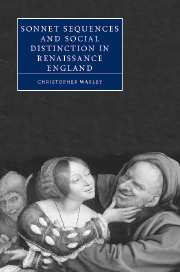Book contents
- Frontmatter
- Contents
- Preface
- 1 Sonnet sequences and social distinction
- 2 Post-romantic lyric: class and the critical apparatus of sonnet conventions
- 3 “An Englishe box”: Calvinism and commodities in Anne Lok's A Meditation of a Penitent Sinner
- 4 “Nobler desires” and Sidney's Astrophil and Stella
- 5 “So plenty makes me poore”: Ireland, capitalism, and class in Spenser's Amoretti and Epithalamion
- 6 “Till my bad angel fire my good one out”: engendering economic expertise in Shakespeare's Sonnets
- 7 “The English straine”: absolutism, class, and Drayton's Ideas, 1594–1619
- Afterword: Engendering class: Drayton, Wroth, Milton, and the genesis of the public sphere
- Notes
- Index
- Cambridge Studies in Renaissance Literature and Culture
7 - “The English straine”: absolutism, class, and Drayton's Ideas, 1594–1619
Published online by Cambridge University Press: 22 September 2009
- Frontmatter
- Contents
- Preface
- 1 Sonnet sequences and social distinction
- 2 Post-romantic lyric: class and the critical apparatus of sonnet conventions
- 3 “An Englishe box”: Calvinism and commodities in Anne Lok's A Meditation of a Penitent Sinner
- 4 “Nobler desires” and Sidney's Astrophil and Stella
- 5 “So plenty makes me poore”: Ireland, capitalism, and class in Spenser's Amoretti and Epithalamion
- 6 “Till my bad angel fire my good one out”: engendering economic expertise in Shakespeare's Sonnets
- 7 “The English straine”: absolutism, class, and Drayton's Ideas, 1594–1619
- Afterword: Engendering class: Drayton, Wroth, Milton, and the genesis of the public sphere
- Notes
- Index
- Cambridge Studies in Renaissance Literature and Culture
Summary
Drayton and absolutism
Why does the sonnet sequence gradually fall from literary favor in the seventeenth century? After all, if the claims that I have been making for sonnet sequences are true – that they are a site for the creation of class as a new means of producing social distinction – shouldn't sequences have become a dominant genre as social relations in England continued to change, as class became an increasingly explicit social phenomenon? Tracing Drayton's changes to his sonnet sequences Idea helps to answer this question. While he composed the first version of his sequence at the height of Elizabethan sonneteering in 1594, Drayton repeatedly and substantially revised Idea over the next twenty-five years, publishing a final version in 1619. The changes Drayton makes embody the shifting literary taste for sonnet sequences, but they also participate in the social transformations within which that taste emerges. These changes are especially apparent in the models that Drayton chooses. Like other sonneteers, Drayton initially takes “diuine Sir Philip” as his principal model, but after 1603 he patterns his poetic voice less on Sidney and more on King James' status as what Jonathan Goldberg influentially describes as the “Poet-King” – James' capacity to maintain and create his monarchical authority in part by fashioning himself as a poet. As a result of this shift, Drayton's sequence moves from articulating a noble imaginary – an Astrophil – to confronting the reconstruction of social space more explicitly.
- Type
- Chapter
- Information
- Sonnet Sequences and Social Distinction in Renaissance England , pp. 152 - 174Publisher: Cambridge University PressPrint publication year: 2005



